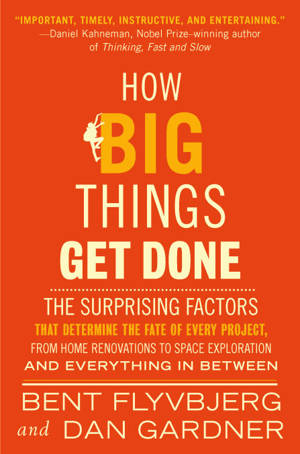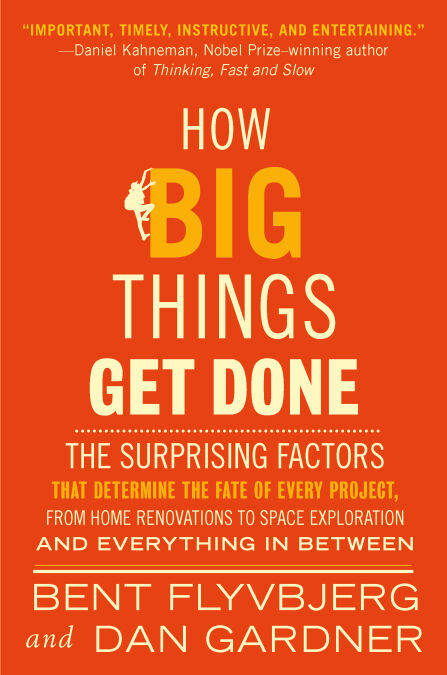
- Retrait gratuit dans votre magasin Club
- 7.000.000 titres dans notre catalogue
- Payer en toute sécurité
- Toujours un magasin près de chez vous
- Retrait gratuit dans votre magasin Club
- 7.000.0000 titres dans notre catalogue
- Payer en toute sécurité
- Toujours un magasin près de chez vous
How Big Things Get Done EBOOK
The Surprising Factors That Determine the Fate of Every Project, from Home Renovations to Space Exploration and Everything In Between
Bent Flyvbjerg, Dan Gardner
Ebook | Anglais
17,96 €
+ 17 points
Format
Description
“Why do big projects go wrong so often, and are there any lessons you can use when renovating your kitchen? Bent Flyvbjerg is the ‘megaproject’ expert and Dan Gardner brings the storytelling skills to How Big Things Get Done, with examples ranging from a Jimi Hendrix studio to the Sydney Opera House.”—Financial Times
“Entertaining . . . There are lessons here for managers of all stripes.”—The Economist
A BEST BOOK OF THE YEAR: Economist, Financial Times, CEO Magazine, Morningstar
Finalist for the Porchlight Business Book Award, the Financial Times and Schroders Business Book of the Year Award, and the Inc. Non-Obvious Book Award
Nothing is more inspiring than a big vision that becomes a triumphant, new reality. Think of how the Empire State Building went from a sketch to the jewel of New York’s skyline in twenty-one months, or how Apple’s iPod went from a project with a single employee to a product launch in eleven months.
These are wonderful stories. But most of the time big visions turn into nightmares. Remember Boston’s “Big Dig”? Almost every sizeable city in the world has such a fiasco in its backyard. In fact, no less than 92% of megaprojects come in over budget or over schedule, or both. The cost of California’s high-speed rail project soared from $33 billion to $100 billon—and won’t even go where promised. More modest endeavors, whether launching a small business, organizing a conference, or just finishing a work project on time, also commonly stall out. But why do some projects fail?
Understanding what distinguishes the triumphs from the failures has been the life’s work of Oxford professor Bent Flyvbjerg, dubbed “the world’s leading megaproject expert.” In How Big Things Get Done, he identifies the errors in judgment and decision-making that lead projects, both big and small, to fail, and the research-based principles that will make you succeed with yours. For example:
• Understand your odds. If you don’t know them, you won’t win.
• Plan slow, act fast. Getting to the action quick feels right. But it’s wrong.
• Think right to left. Start with your goal, then identify the steps to get there.
• Find your Lego. Big is best built from small.
• Be a team maker. You won’t succeed without an “us.”
• Master the unknown unknowns. Most think they can’t, so they fail. Flyvbjerg shows how you can.
• Know that your biggest risk is you.
Full of vivid examples ranging from the building of the Sydney Opera House, to the making of Pixar blockbusters, to a home renovation in Brooklyn gone awry, How Big Things Get Done reveals how to get any ambitious project done—on time and on budget.
“Entertaining . . . There are lessons here for managers of all stripes.”—The Economist
A BEST BOOK OF THE YEAR: Economist, Financial Times, CEO Magazine, Morningstar
Finalist for the Porchlight Business Book Award, the Financial Times and Schroders Business Book of the Year Award, and the Inc. Non-Obvious Book Award
Nothing is more inspiring than a big vision that becomes a triumphant, new reality. Think of how the Empire State Building went from a sketch to the jewel of New York’s skyline in twenty-one months, or how Apple’s iPod went from a project with a single employee to a product launch in eleven months.
These are wonderful stories. But most of the time big visions turn into nightmares. Remember Boston’s “Big Dig”? Almost every sizeable city in the world has such a fiasco in its backyard. In fact, no less than 92% of megaprojects come in over budget or over schedule, or both. The cost of California’s high-speed rail project soared from $33 billion to $100 billon—and won’t even go where promised. More modest endeavors, whether launching a small business, organizing a conference, or just finishing a work project on time, also commonly stall out. But why do some projects fail?
Understanding what distinguishes the triumphs from the failures has been the life’s work of Oxford professor Bent Flyvbjerg, dubbed “the world’s leading megaproject expert.” In How Big Things Get Done, he identifies the errors in judgment and decision-making that lead projects, both big and small, to fail, and the research-based principles that will make you succeed with yours. For example:
• Understand your odds. If you don’t know them, you won’t win.
• Plan slow, act fast. Getting to the action quick feels right. But it’s wrong.
• Think right to left. Start with your goal, then identify the steps to get there.
• Find your Lego. Big is best built from small.
• Be a team maker. You won’t succeed without an “us.”
• Master the unknown unknowns. Most think they can’t, so they fail. Flyvbjerg shows how you can.
• Know that your biggest risk is you.
Full of vivid examples ranging from the building of the Sydney Opera House, to the making of Pixar blockbusters, to a home renovation in Brooklyn gone awry, How Big Things Get Done reveals how to get any ambitious project done—on time and on budget.
Spécifications
Parties prenantes
- Auteur(s) :
- Editeur:
Contenu
- Nombre de pages :
- 304
- Langue:
- Anglais
Caractéristiques
- EAN:
- 9780593239520
- Date de parution :
- 06-02-23
- Format:
- Ebook
- Protection digitale:
- Adobe DRM
- Format numérique:
- ePub

Les avis
Nous publions uniquement les avis qui respectent les conditions requises. Consultez nos conditions pour les avis.






